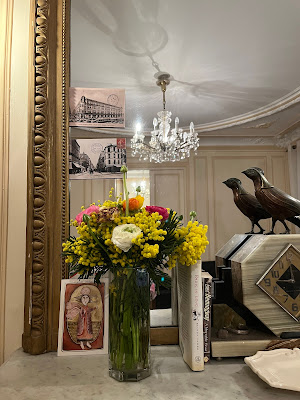Kate and I have enjoyed going to our local Marché every Thursday and Saturday. This Thursday we decided we needed some flowers to brighten up the apartment and Kate chose ranunculus and mimosas and arranged them in a vase for the mantle.
We hope the flowers bring on spring a bit faster. We had a sunny window Friday that was bookended with rain in the morning and evening so Kate and I took advantage of the sunshine to walk over to the Musée Rodin on the other side of Les Invalides.
 |
Kate at Les Invalides with her new Rive Gauche
bag from a shop in the Marais |
It had been many years since Kate had been to the Rodin Museum in the Hôtel Biron on rue Varennes.
 |
| Musée Rodin |
The gardens are lovely, especially in the warmer months, with beautiful views everywhere. We love how there are statues outside as well as inside.
 |
| View of the Tour Eiffel from the front gardens |
 |
Le Penseur with Dome
of Les Invalides behind |
The Gates of Hell, depicting a scene from Dante's Inferno, were never cast and assembled as a whole during Rodin's lifetime. The Thinker is taken from these gates-you can see him perched in the center near the top.
 |
| Kate in front of the Gates of Hell |
One of my favorite sculptures at the museum is the monument to the Burghers of Calais. This is what the museum says about the sculpture:
"This monument, commissioned to Rodin in 1884 by the city of Calais, celebrates the collective sacrifice of six notables who went to hand over the keys of the city to the victorious King of England at the end of the siege of 1346-47 during the Hundred Years' War. The six characters are individualized, united on the same base, but independent. Alone facing their destiny and death, they do not look at each other, do not touch. Simply dressed in a tunic, with a rope around their necks and bare feet, the condemned men begin their slow funeral march. Rodin gives each figure, studied naked before being draped in the condemned man's tunic, a particular gesture and movement - from despair to abandonment, from confidence to resignation.
The monument, completed in 1889, was installed in 1895 in the square of the town hall in Calais, without however respecting Rodin's wish that it be presented very high up - so that the figures would stand out against the sky - or on the ground, "right on the flagstones of the square, like a living string of suffering and sacrifice" (Rodin)."
I love Rodin's vision of how the statue should be displayed.
 |
| Burghers of Calais |
Right inside the first room of the museum is a sculpture of Rodin done by his student, Antoine Bourdelle. This statue, another of my favorites, is also in the garden of the Bourdelle museum we love near Montparnasse. It is inscribed “To Master Rodin, these reassembled profiles.” It was a bit controversial at the time. But Bourdelle was capturing the inner Rodin from different angles all at once. He revered Rodin and worked with him as his pupil for 15 years.
The combination of the sculptures and views out to the gardens in this beautiful mansion are stunning.
 |
| A Burher of Calais |
Rodin was also a painter and collected art from fellow artists. He also collected antiquities to use to teach his students. He left this mansion and all the art in it to France around the time of World War I.
 |
The Wedding of Marie de Medici
by Auguste Rodin |
 |
| The Kiss |
I love his depiction of the writer Balzac in his monk's robe. It is so powerful and was another controversial work of Rodin. This statue also appears by the entrance to the Vavin métro stop. It was the stop we used when Kelly and I lived on rue d'Assas and met on study abroad in 1980.
 |
| View out the front of the Museum |
 |
| Honoré de Balzac |
 |
| View to back garden |
 |
| Entry Stairway |
The museum had two wonderful Van Gogh paintings. One was Père Tanguy in a Breton costume against a backdrop of Van Gogh's favorite Japanese prints he collected. Tanguy ran a small paint supplies shop and often accepted paintings as payment for supplies. The other painting is a scene in Arles and is called The Blue Train. Rodin admired Van Gogh, whom he regarded as “an admirable demolisher of academic formulae, [who] also had a genius for light.”
 |
| Père Tanguy |
 |
| Le Train Bleu |
I love his depictions of creation-the hands and Adam and Eve emerging from the marble.
 |
| Les Mains |
 |
| Adam and Eve |
The Rodin is such a lovely museum and not too big so it is easy to digest.
 |
| View of Les Invalides Dome |
After the museum we came across a little butcher shop with a darling sign. It says the shop has been there since 1959.
 |
| Boucher Depuis 1959 |
By the time we headed home the sky was gray once again. We were happy we had found a window of sunshine on a cold January day in Paris to enjoy the Rodin Museum.
























No comments:
Post a Comment